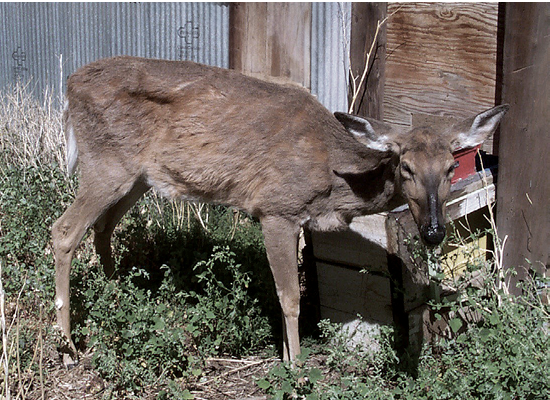What You Need to Know about Chronic Wasting Disease in Mississippi Deer
On February 9, 2018, the Mississippi Department of Wildlife, Fisheries, and Parks reported that a 4-year-old white-tailed deer buck in Issaquena County, Mississippi, had tested positive for chronic wasting disease (CWD). We compiled this fact sheet to answer frequently asked questions about this serious issue, which could have long-term implications for Mississippi hunters, wildlife managers, and people who love the outdoor life.
What Is CWD?
CWD is a contagious and fatal neurological disease that affects deer, including white-tailed deer, mule deer, elk, moose, and caribou. It causes a spongy degeneration of the brain of an infected animal. It also causes the animal to lose weight, which is why CWD is called a “wasting” disease.
CWD also causes the infected animal to behave in unusual ways, such as not being afraid of people. Eventually, the infected animal will lose control of its bodily functions and die soon after. CWD is always fatal.
CWD is one of a group of related diseases known as transmissible spongiform encephalopathies (TSEs). These diseases also include scrapie in sheep, bovine spongiform encephalopathy (also known as “mad cow” disease) in cattle, and Creutzfeldt-Jakob disease, which affects people.
In the United States, CWD was first recognized in captive mule deer in Colorado in 1967, but it was not understood to be a TSE until the 1970s.
How Is CWD Transmitted?
It is not completely clear how CWD is transmitted. The infectious agent, a type of protein called a prion, may be passed in urine, feces, or saliva. The incubation period—the time between the infection and the development of the disease—appears to be about 16 months. It is unknown at which point the infected animal begins shedding the CWD agent, which allows the infection to spread to other animals.
The CWD agent is known to be very resistant to the environment, so it can be transmitted directly, from one animal to another, or indirectly, from a contaminated surface, such as a deer feeder, to another animal.
What is known is that the movement of live animals is one of the greatest risk factors in spreading the disease from one population to another or from one geographic area to another.

How Will a Ban on Feeding Deer Help?
Feeding deer won’t cause the disease, of course, but it causes the animals to concentrate their populations around the feed source. Bringing a large number of animals together increases the possibility that the disease will spread. If just one CWD-infected animal comes to a feeder, the chance that the disease will spread to other deer is far greater than if those deer were browsing normally in the wild.
As of February 15, 2018, all deer feeding is banned in six Mississippi counties: Claiborne, Hines, Issaquena, Sharkey, Warren, and Yazoo.
What Are the Visible Symptoms of CWD?
The most consistent and obvious symptom is weight loss. The deer looks like it is literally wasting away. CWD-affected deer will continue to eat, but the amount they consume decreases. Other signs are excessive drinking and urination, which occur in late stages of the disease.
Behavior changes are also noticeable. An infected animal will drool, lower its head, walk in repetitive patterns, have a blank facial expression, and even grind its teeth.
How Is CWD Detected?
The changes in physical appearance and behavior are good indications, but to officially diagnose CWD, a postmortem tissue sample is needed for laboratory testing. There is currently no reliable test that can be performed on a live animal.
Can People Catch CWD?
So far, it has not been proven that CWD poses a risk to people. There has never been a reported case of a human contracting the disease from a deer or from infected deer meat. However, public-health professionals recommend that people avoid any exposure to CWD.
Is It Safe to Eat Venison from Mississippi Deer?
In general, yes, it is safe to eat venison. However, people should not eat meat from deer known or suspected to be infected with CWD. Hunters and others in the six-county area of the feeding ban should handle venison with extreme care.
When field-dressing an animal or butchering the carcass, wear rubber or latex gloves and debone the meat. Do not saw through the bones, and don’t cut through the skull or spinal cord. Don’t handle or consume brain, spleen, lymph, or spinal tissue because the CWD agent accumulates in these tissues.
As always, wash your hands and instruments thoroughly after field-dressing the animal or deboning the meat.
If you have your venison processed, request that the meat from your deer be processed separately and not mixed with meat from other deer.
What Does CWD Mean for the Future of Deer and Deer Hunting?
The impact of CWD on populations of deer and elk is not fully understood. Computer modeling suggests that, over time, the deer herd will be reduced because fewer deer will survive. CWD has already caused changes in the way wild deer and elk populations are managed in other states. And, ultimately, concerns about the risk to human health could cause hunters to be less confident about hunting in CWD-affected areas.
Publication 3199 (POD-02-24)
By Bronson Strickland, PhD, Extension Professor, Wildlife, Fisheries, and Aquaculture.
The Mississippi State University Extension Service is working to ensure all web content is accessible to all users. If you need assistance accessing any of our content, please email the webteam or call 662-325-2262.


